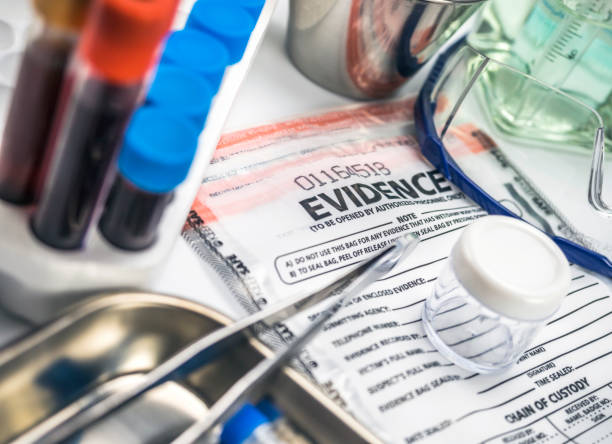
August 14, 2023
The Use ₰ Misuse of Forensic Evidence in Criminal Investigations
Forensic evidence has been crucial component in the field of investigations for decades. It plays a very essential role in identifying suspects, linking them to crime scenes, which aiding in the delivery of Justice. From fingerprint analysis to DNA testing, the techniques of forensic applications have revolutionized the justice system. However, the reliance on forensic evidence is not without its challenges. In recent years, concerns have arisen regarding its misuse and the potential for wrongful conviction.
The Role of Forensic Evidence in Criminal Investigations
Forensic evidence includes a wide range of scientific disciplines, including DNA analysis, fingerprinting, ballistics, toxicology, and more. These techniques are aimed to link suspects to the crime scene, establish timelines, reconstruct events, and identify potential motives. When properly collected, analyzed, and interpreted, it can provide valuable information for law enforcement and judicial systems.
Advantages of Forensic Evidence
One of the significant advantages of forensic evidence is its objectivity. It relies on scientific principles and method. In addition, the use of such evidence can strengthen the case against criminals, increase the likelihood of obtaining convictions, and act as a deterrent against future criminal behavior.
The Misuse of Forensic Evidence
Despite of its many advantages, forensic evidence is not infallible (not liable to error) and it can also be misused during criminal investigations. In such cases, forensic science practitioners provided misleading testimony that exaggerated the connection between the crime scene evidence and the person of interest. In other cases, its misuse can occur due to several reason: –
Inadequate Training and Resources: Insufficient training or lack of resources in forensic laboratories can lead to errors in evidence collection, analysis, and interpretation.
Confirmation Bias: Investigators and analysts might unknowingly be influenced by pre-existing beliefs about a case, leading to selective interpretation of evidence.
Inaccurate Techniques: Some forensic techniques, such as bite mark analysis or hair comparison, lack scientific validity and have resulted in wrongful convictions.
Overstating Certainty: Experts presenting forensic evidence may sometimes overstate the certainty of their conclusions, potentially swaying juries.
Contaminated sample: Improper handling, collection or storage of evidence can result in contamination, compromising the accuracy of forensic analysis which can again be misused by parties to the case.
Some important case laws relating forensic evidences: –
1. Mukesh and Another v. (NCT of Delhi) and Others, 2017
Facts: –
The Appellants were convicted and sentenced to death for the gangrape and murder of the prosecutrix. Along with other evidence, the prosecution relied on DNA evidence to convict the appellants. While confirming the conviction and sentence, the Supreme Court discussed the importance of DNA evidence.
Findings: –
The Court held that a DNA report deserves to be accepted unless it is absolutely dented. In case the DNA report is rejected, it must be established that there had been no quality control or quality assurance. A DNA report should be accepted if there is no error in sampling and no indication of tampering of samples.
2. Shankaria v. State of Rajasthan, 1978
Facts: –
This case pertains to a double murder. The appellant was sentenced to death by the Trial Court which was then confirmed by the High Court. Moulds were prepared from the foot-prints of the suspected culprit and matched with the footprints of the appellant. At trial, the expert testified that the foot-mould of one of the bare footprints found at the scene of crime tallied with the specimen left foot-mould of the appellant.
Findings: –
On the point of the footprint evidence, the SC held that the science of identification of foot-prints is not a developed science, and thus, it is not sufficient for a conviction. However, it is a relevant circumstance which can be taken into account along with the other evidence and may then reinforce the conclusion on the identity of the culprit.
3. Hariom and hero v. State of Uttar Pradesh,2021
Facts: –
The case involved six accused who were convicted for dacoity and murder of four individuals. Three of the convicted persons were acquitted by the High Court while the sentence imposed on others which was primarily based on fingerprint examination, which matched the latent prints found on the items in the deceased’s house with exemplar prints of the appellants.
Findings: –
While dismissing the fingerprint evidence, the Supreme Court held that the method applied for lifting latent prints from the items found in the deceased’s house was not specified in the fingerprint report. The Court also noted that the record does not show if the items from which the latent prints were lifted were available for analysis by the Fingerprint Bureau. Finally, the Supreme Court questioned the training, and experience of the Constable who had lifted the latent prints. The Court held that the report of the Fingerprint Bureau was unreliable. Even if the fingerprint evidence was admitted, there was absence of substantive evidence to link the Appellants to the crime. Considering this, the SC acquitted the three Appellants.
Conclusion
Forensic evidence plays a critical role in modern criminal investigations, contributing significantly to the pursuit of justice and public safety. However, its misuse can lead to grave consequences, damaging the integrity of the justice system. By prioritizing rigorous training, independent reviews, and standardized protocols, society can harness the true potential of forensic evidence while safeguarding against wrongful convictions and upholding the principles of justice.
FOLLOW US MORE: – www.thesupremerights.com
FOLLOW US ON INSTAGRAM:- @thesupremerights

